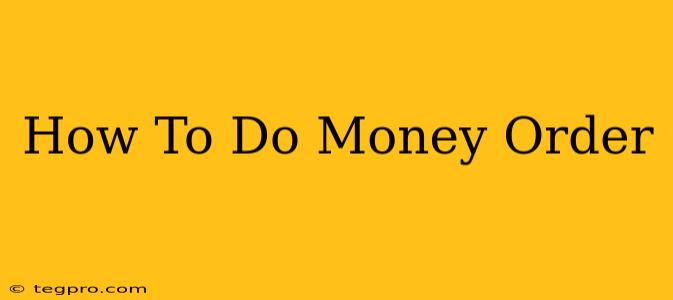Sending money has never been easier. While digital methods like Venmo and PayPal dominate, the humble money order remains a reliable option, particularly for those without bank accounts or who prefer a more secure, traceable method of payment. This comprehensive guide will walk you through everything you need to know about how to do a money order, from purchasing to tracking.
Understanding Money Orders
Before diving into the process, it's crucial to understand what a money order is and why you might choose it. A money order is a payment instrument similar to a check, but it's guaranteed by a third party – typically a post office, bank, or retailer. This guarantee provides added security for the recipient, making it a preferred payment method for some transactions.
Key benefits of using a money order:
- Security: Unlike personal checks, money orders are less susceptible to fraud and bounce.
- Traceability: Money orders can be tracked, providing peace of mind for both sender and recipient.
- Accessibility: Money orders are available even without a bank account.
- Acceptance: Many businesses, landlords, and individuals accept money orders as a form of payment.
Where to Purchase Money Orders
Several locations offer money order services:
- Post Offices: USPS money orders are widely accepted and offer a degree of security. They usually have a small fee.
- Banks and Credit Unions: Many financial institutions sell money orders to their customers and non-customers alike. Fees may vary.
- Retailers: Stores like Walmart, Kroger, and CVS often sell money orders, providing a convenient option for quick purchases. Check with your local store for availability and fees.
How to Fill Out a Money Order
Filling out a money order correctly is vital. Incorrect information can lead to delays or rejection. Here's a step-by-step guide:
1. Pay to the Order Of: Write the recipient's full name and address clearly in this section. Accuracy is paramount.
2. Amount: Write the amount in both numerals and words. Ensure both figures match precisely to avoid discrepancies.
3. Your Information: Enter your full name and address in the designated space. This allows the issuer to contact you if needed.
4. Date: Fill in the current date.
5. Sign the Money Order: Sign in the space provided. This validates the money order.
Important Considerations When Filling Out Your Money Order:
- Use a pen: Avoid using pencil as it can be easily erased.
- Neatness counts: Illegible handwriting can cause delays or rejection.
- Double-check: Carefully review the information before submitting the money order. Errors are difficult (and often impossible) to correct.
Tracking Your Money Order
Depending on where you purchased your money order, you may be able to track its status. For USPS money orders, you can often track them using their online tracking system. Other issuers may have different methods or may not provide tracking at all.
Frequently Asked Questions (FAQs)
Q: What is the cost of a money order?
A: The cost varies depending on the issuer and the amount. Fees typically range from a few dollars to a couple of dollars.
Q: Can I cancel a money order?
A: Generally, it's very difficult to cancel a money order once it's been issued.
Q: Are there any limits on the amount of a money order?
A: Limits vary depending on the issuer. Some may have a maximum amount per transaction.
Q: What if the money order is lost or stolen?
A: Report it immediately to the issuing institution. They may be able to provide a replacement or assistance.
By following these steps and understanding the nuances of money orders, you'll be able to use this reliable payment method with confidence. Remember, accuracy and attention to detail are key to a smooth transaction.

